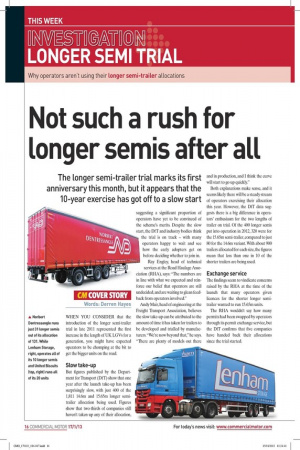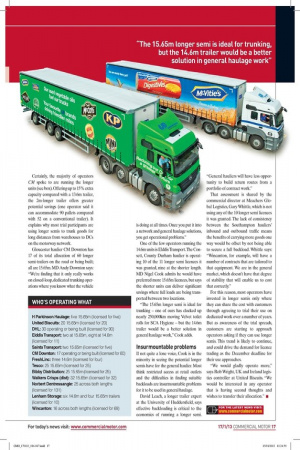Not such a rush for Longer semis after all
Page 11

Page 12

If you've noticed an error in this article please click here to report it so we can fix it.
The longer semi-trailer trial marks its first anniversary this month, but it appears that the 10-year exercise has got off to a slow start WHEN YOU CONSIDER that the introduction of the longer semi-trailer trial in late 2011 represented the first increase in the length of UK LGVs for a generation, you might have expected operators to be chomping at the bit to get the bigger units on the road.
Stow take-up But figures published by the Department for Transport (DfT) show that one year after the launch take-up has been surprisingly slow, with just 400 of the 1,811 14.6m and 15.65m longer semitrailer allocation being used. Figures show that two-thirds of companies still haven't taken up any of their allocation, suggesting a significant proportion of operators have yet to be convinced of the scheme's merits. Despite the slow start, the DfT and industry bodies think the trial is on track — with many operators happy to wait and see how the early adopters get on before deciding whether to join in.
Ray Engley, head of technical services at the Road Haulage Association (RHA), says: "The numbers are in line with what we expected and reinforce our belief that operators are still undecided, and are waiting to glean feedback from operators involved."
Andy Mair, head of engineering at the Freight Transport Association, believes the slow take-up can be attributed to the amount of time it has taken for trailers to be developed and trialled by manufacturers. "We're now beyond that," he says. "There are plenty of models out there and in production, and I think the curve will start to go up quickly."
Both explanations make sense, and it seems likely there will be a steady stream of operators exercising their allocation this year. However, the DfT data suggests there is a big difference in operators' enthusiasm for the two lengths of trailer on trial. Of the 400 longer semis put into operation in 2012, 320 were for the 15.65m semi-trailer, compared to just 80 for the 14.6m variant. With about 900 trailers allocated for each size, the figures mean that less than one in 10 of the shorter trailers are being used.
Exchange service The findings seem to vindicate concerns raised by the RHA at the time of the launch that many operators given licences for the shorter longer semitrailer wanted to run 15.65m units.
The RHA wouldn't say how many permits had been swapped by operators through its permit exchange service, but the DfT confirms that five companies have handed back their allocations since the trial started.
Certainly, the majority of operators CM spoke to are running the longer units (see box). Offering up to 15% extra capacity compared with a 13.6m trailer, the 2m-longer trailer offers greater potential savings (one operator said it can accommodate 90 pallets compared with 52 on a conventional trailer). It explains why most trial participants are using longer semis to trunk goods for long distances from warehouses to DCs on the motorway network.
Gloucester haulier CM Downton has 17 of its total allocation of 60 longer semi-trailers on the road or being built; all are 15.65m. MD Andy Downton says: "We're finding that it only really works on closed-loop, dedicated trunking operations where you know what the vehicle is doing at all times. Once you put it into a network and general haulage solutions, you get operational problems."
One of the few operators running the 14.6m units is Elddis Transport. The Conseil, County Durham haulier is operating 10 of the 11 longer semi licences it was granted, nine at the shorter length. MD Nigel Cook admits he would have preferred more 15.65m licences, but says the shorter units can deliver significant savings where full loads are being transported between two locations.
"The 15.65m longer semi is ideal for trunking — one of ours has clocked up nearly 250,000km moving Velvet toilet rolls for SCA Hygiene — but the 14.6m trailer would be a better solution in general haulage work," Cook adds.
Insurmountable problems If not quite a lone voice, Cook is in the minority in seeing the potential longer semis have for the general haulier. Most think restricted access at retail outlets and the difficulties in finding suitable backloads are insurmountable problems for it to be used in general haulage.
David Leach, a longer trailer expert at the University of Huddersfield, says effective backloading is critical to the economics of running a longer semi.
"General hauliers will have less opportunity to build return routes from a portfolio of contract work."
That assessment is shared by the commercial director at Meachers Global Logistics, Gary Whittle, which is not using any of the 10 longer semi licences it was granted. The lack of consistency between the Southampton hauliers' inbound and outbound traffic means the benefits of carrying more goods one way would be offset by not being able to secure a full backload. Whittle says: "Wincanton, for example, will have a number of contracts that are tailored to that equipment. We are in the general market, which doesn't have that degree of stability that will enable us to cost that correctly."
For this reason, most operators have invested in longer semis only where they can share the cost with customers through agreeing to trial their use on dedicated work over a number of years. But as awareness of the trial spreads, customers are starting to approach operators asking if they can use longer semis. This trend is likely to continue, and could drive the demand for licence trading as the December deadline for their use approaches.
"We would gladly operate more," says Rob Wright, UK and Ireland logis- tics controller at United Biscuits. "We would be interested in any operator that is having second thoughts and wishes to transfer their allocation." • WHO'S OPERATING WHAT H Parkinson Haulage: five 15.65m (licensed for five) United Biscuits: 20 15.65m (licensed for 20) DHL: 30 operating or being built (licensed for 90) Elddis Transport: two at 15.65m, eight at 14.6m (licensed for 11) Saints Transport: two 15.65m (licensed for five) CM Downton: 17 operating or being built (licensed for 60) FreshLinc: three 14.6m (licensed for four) Tesco: 25 15.65m (licensed for 25) Bibby Distribution: 25 15.65m (licensed for 25) Walkers Crisps (dist): 32 15.65m (licensed for 32) Norbert Dentressangle: 25 across both lengths (licensed for 131) Lenham Storage: six 14.6m and four 15.65m trailers (licensed for 10) Wincanton: 16 across both lengths (licensed for 69)








































